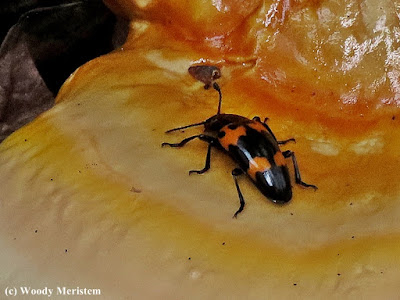Yes indeed, there’s always something
interesting to see in the great outdoors.
On a mostly cloudy morning I went for a walk in a
nearby woodland. It was a slow, lazy walk that afforded an opportunity to look
around. This was a woodland inhabited by deer, bear, wild turkey, bobcat, fisher,
eastern coyote, and a host of songbirds – hopefully there would be one or more
of them available for an intrepid photographer.
Other than a few tree-top songbirds, only one
of those photogenic creatures was ever in view. But there are always
interesting things to see: First was an abundance of wild geraniums growing
along the old road on which I walked. Wild geranium flowers are often an
interesting reddish-blue, not really purple, that most digital cameras have
difficulty capturing.
Further along was a small adventitious sprout
on the trunk of a tulip-poplar. All broadleaved trees have, beneath their bark,
adventitious buds that usually remain dormant but often become active when a
tree is under stress. I thought the two little leaves on this sprout were
photogenic –
In a sunny spot a number of small butterflies
were flying and repeatedly landing on a sun-heated log to warm their flight
muscles. They were all of the same species, one of a large group of generally drab,
difficult to identify, butterflies called skippers –
This woodland has several groves of hickory
trees whose nuts attract squirrels, black bears and wild turkeys in fall, but
this was late spring, not fall, so none of those were present. But, the leaves
of a small shagbark hickory were inhabited by the larvae of a gall midge (a
type of fly), each larva produced a small round gall on the leaves –
The old road on which I was walking also passes
through a stand of eastern hemlock, many of which have died in the last few
years. One of the fallen hemlocks was being broken down by the fungus usually
called varnish conk for its shiny appearance. What would the world be like
without the decomposers?
On that conk was a beetle, one of a small
group known as pleasing fungus beetles, all of which are brightly colored in
orange and black and feed on a variety of fungi, especially mushrooms.
There are several small grassy openings in
this woodland. As I walked past one of those, about 200 feet away a white-tail
doe was feeding. She was remarkably calm, seeming to pay no attention to a
human from which she would have fled mere weeks ago. Her apparent calm may well
have been a bluff – this was birthing time for white tailed deer and the does
like to hide their new-born fawns in grassy fields. It was better to enjoy the
sight of the doe and not search for the fawn –
Beneath a clump of small beech trees was a group
of squawroot in bloom. Squawroot is a flowering plant that lacks chlorophyll
and so cannot produce its own sugars, instead it’s a parasite on oak and beech
trees. Black bears frequently eat squawroot flowers, so the plant is sometimes called bear corn or bear cones. Most of the plant is underground, the flowering stalks appear above ground
in late spring when the plant blooms –
Something
dangling from a branch over the old road caught my eye. It was out of reach but
my alpenstock easily caught the silken thread which held it in mid-air and brought it within reach. What
was it? Lo and behold, it was a pair of jumping spiders –
One of the many small blue butterflies that frequent spring woodlands is the eastern tailed blue. And tailed it is, not like the gaudy tiger swallowtail that also frequents spring woodlands, but with smaller discrete tails on its smaller, less conspicuous self –
And thus endith a morning walk in the woods –
see, there’s always something interesting.










When you mention bear, bobcat and fisher that definitely sounds like a northern forest to me.
ReplyDeletefirst photo of flower and the last photo of butterfly are so attractive for me.
ReplyDeleteGot knowledge by reading your descriptions.
Have a great day
Good to see all that you shared...especially mamma deer.
ReplyDeleteIch bin jetzt gerne mit auf dem morgendlichen Spaziergang mitgegangen. Interessanter Beitrag und schöne Bilder.
ReplyDeleteL G Pia
Hello,
ReplyDeleteGreat nature scenes and photos. Cool captures of the insects and I love the last little butterfly. I have seen the Bear Corn, I did not know what it was. Now thanks to you I know the it's Squawroot. Pretty deer!
Thank you for linking up and sharing your post. Enjoy your day, have a happy weekend.
Hello. Lovely post. Photos are wonderful. Thank you for sharing.
ReplyDeleteWhat a wonderful array of wildlife. Fantastic pictures.
ReplyDeleteSo lovely!
ReplyDelete